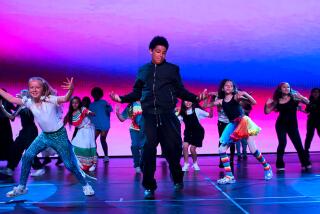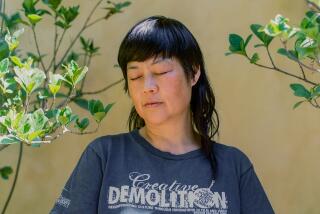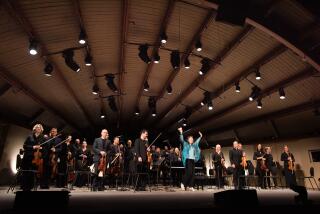DEATH HALTS SANKAIJUKU TOUR
- Share via
Sankaijuku’s entire scheduled American tour--including Los Angeles dates later this month and early October--has been canceled in the aftermath of the accident that killed performer Yoshiyuki Takada during the company’s celebrated “hanging dance” in Seattle on Tuesday afternoon.
Robert Fitzpatrick, director of the Olympic Arts Festival and booking agent for the five-member Tokyo-based group, said “they will not perform for a year.”
An eight-year veteran of Sankaijuku, Takada fell six stories when the rope holding him snapped just after he and three other members of the avant-garde Japanese company began lowering themselves from the top of the Mutual Life Building in Pioneer Square. He died at Harborview Medical Center shortly after the accident.
Until Tuesday, Sankaijuku had performed its “hanging dance” in cities throughout the world without mishap. Nearly naked, hairless, powdered white--with touches of red at the fingertips--they were slowly lowered upside down, hanging by their ankles while they clawed the air or sometimes just let their fingers slowly pulse like the movements of small undersea creatures.
During the Olympic Arts Festival last July, the company had descended from the roof of the Dorothy Chandler Pavilion and had also performed a theater piece, “Jomon Sho” (“Homage to Pre-History”), in Pasadena Civic Auditorium.
Fitzpatrick explained Tuesday, just after Takada’s death, that “at the Olympic Arts Festival, they (Sankaijuku) were meticulous in checking the rigging” for the “hanging dance.” But, after talking with company members and the production staff in Seattle, he said Wednesday morning that there was “some doubt about whether all four lines had been tested with sandbags--a question about whether the risk had become routine and they didn’t do all the tests.”
Following the company’s Pavilion “hanging dance” in 1984, a member of Circus Oz told The Times that when he examined Sankaijuku’s hemp rigging, he found it unsafe--not strong or stable enough for the risk.
Fitzpatrick insisted Tuesday, though, that “these were not daredevils or thrill-seekers. These were artists sharing a vision. They felt it (the “hanging dance”) was indeed risk-taking, but not imprudent risk. They chose to take risks because of the fulfillment of their personal vision.”
In a Times interview with Jeff Spurrier that was published before Sankaijuku’s performances at the festival, Takada explained that in the form of Japanese dance-theater called butoh, “our main theme is life and death, so we try to realize the situation of death and the state of just being born.”
“When we are born, we first realize the situation of death. The mind is nothing, just like the body. That’s why we are white and we shave our bodies--to be nothing.”
The company had been scheduled to return to Los Angeles later this month for an outdoor performance on the “Explorations III” series at the Japan America Theatre and six performances at Pasadena Civic Auditorium--besides another hanging event at noon on Sept. 27 at the theater. Ticketholders seeking refunds can obtain them at point of purchase. (For information: 818-449-7360.)
When he arrrived in Seattle late Tuesday night, Fitzpatrick went to Pioneer Square and in a phone interview the next morning described the site as “covered with candles, flowers, messages written on napkins.” One note read “It was the most beautiful thing I had ever seen before he fell and after, I was lost.” Another began “The man fell while I watched. He was dead before we scarcely knew he was alive” and went on to make the onlookers a “party to his death.”
Fitzpatrick also said that the surviving company members had performed a ritual cleansing of Takada’s body prior to an autopsy and that Takada’s parents would arrive from Japan later that day to take his body back for burial.
To Fitzpatrick, the members of Sankaijuku are “artists redefining the territory of dance,” a concern that has occupied the American modern dance avant-garde for the past two decades. Many of the early experiments by Trisha Brown, Twyla Tharp, Meredith Monk and others dealt with expanding the space for dance--putting dance in places where it had never existed before.
More recently, this testing of limits has inspired a generation of choreographers to investigate physical risk in their work--a sense of being on the edge. For some, this priority has led to a punishing movement style--dance at the outer limits of strength and stamina.
For others, risk has meant putting oneself beyond normal controls. New York-based performance artist Tim Miller once recruited a company by putting an ad in a newspaper asking for dancers willing to bail out of an airplane at 5,000 feet. Thus, Sankaijuku’s daring--both spatially and physically--exists well within this era’s preoccupations.
On a Sunday stopover in Los Angeles, Sankaijuku leader Ushio Amagatsu spoke in a Times interview with Martin A. David about this “sense of the dramatic, sense of danger” that is part of the company’s performances.
“When I am performing there is no limit,” Amagatsu commented. “However, I don’t want to be killed senselessly.”
To Los Angeles-based performance artist Rachel Rosenthal, the element of risk in the Sankaijuku “hanging dance” is “a byproduct, not a primary issue.”
“I think that what happens with a lot of artists, and non-artists, is that there is a defiance of nature,” Rosenthal said Wednesday. “It has to do with a certain kind of beauty--the beauty of going off balance, the call of going beyond the possible.”
“I think for Sankaijuku and a lot of people who work in this way, the dance of air and gravity and the unnaturalness of being upside down, the use of the laws of nature in order to eradicate them, to make them visible and then to transcend them, is part of the aesthetic. It has to do with going beyond being human.”
Rosenthal observed that this impulse “may be more male than female; it seems to me the female sense of beauty has been in grounding what is.”
Wednesday morning, choreographer Bella Lewitzky (whose Dance Gallery produced the dance component of the festival) spoke of her shock at Takada’s death and remembered her own fear at viewing the “hanging dance” a year ago. “When they appeared, the entire crowd stepped back,” she recalled. “Everybody sensed danger. I was frightened by it because it seemed to me that it had elements of death in it. And I lost that in the magnificence of their control.”
Nevertheless, Lewitzky rejected danger as a sphere of interest in her own choreography, explaining how long it takes to shape a dancer and her reluctance to “take chances with those wonderful instruments. My whole sense is to protect that, not to invite disaster,” she said.
More to Read
The biggest entertainment stories
Get our big stories about Hollywood, film, television, music, arts, culture and more right in your inbox as soon as they publish.
You may occasionally receive promotional content from the Los Angeles Times.










